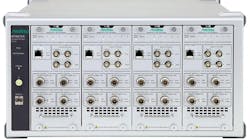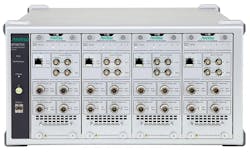This file type includes high-resolution graphics and schematics when applicable.
As the Internet of Things (IoT) continues to emerge, so do demands for efficient testing of the wave of products arriving into this arena. No question, the IoT encompasses a wide range of industries that utilize various wireless technologies. Needless to say, then, that IoT device testing requirements are also great in scope.
Taking a vigilant approach when it comes to test, such as performing testing throughout the product-development cycle, can help companies developing IoT-based products avoid dreaded pitfalls. Such companies are being aided by the latest solutions offered by suppliers of test-and-measurement equipment. For example, wireless test sets that support multiple standards can be used in high-volume manufacturing environments, offering both performance and flexibility. With the impact of IoT looming, proper testing becomes ever-more important for device manufacturers.
Universal IoT Test Solutions
The IoT can mean different things to different people due to its broad appeal. “If you ask 10 people what IoT means, you’re likely to get 10 different answers that range from big data to the connected car,” says Brian Davis, field applications engineer, Wireless Products, Anritsu. “One common denominator in all IoT applications is that products must be connected via wired and/or wireless technologies.
“Most IoT solutions are projected to be relatively close range and will likely use non-cellular technologies, such as Bluetooth low energy (BLE), ZigBee, or possibly point-to-point connections envisioned in the future for 5G,” adds Davis. “Longer-range connections can be provided by cellular or low-power wide-area network (LPWAN) technologies, such as LoRa, Narrowband-IoT (NB-IoT), or 6LoWPAN.”
In terms of IoT performance requirements, several are particularly critical, such as range. Proper testing is needed to ensure that these requirements are met. “In addition to range, one key consideration when selecting the appropriate technology is the reliability requirement of the end application,” says Davis. “For example, a connected car using multiple sensors and a high data rate will require extremely reliable real-time connections. Extensive testing and quality assurance in the manufacturing phase is required in these designs.”
By utilizing a single test platform that is customizable to a user’s specific needs, Anritsu believes that IoT-based testing can be simplified. Davis explains, “Testing IoT devices will vary depending on the technologies chosen for the product and the reliability requirements. IoT device testing, however, does not have to be complex. Wireless IoT technologies are many, but the production testing for all of them is handled in a similar manner. This means that a larger portion of IoT device testing during production can be handled by a single solution—as long as it is a customizable testing platform that can support the most common IoT technologies. One example is our MT8870A universal wireless test set (Fig. 1).
“Solutions such as these consist of a mainframe, measurement modules, and software, allowing users to simply add or remove modules as testing needs to be changed,” he continues. “In addition, the single hardware module architecture, such as in the MT8870A, supports all cellular and non-cellular technologies. If many production lines use the same test platform, it is possible to transfer measurement capacity from one line to the other just by removing and reconnecting a module. This capability makes IoT wireless device manufacturing faster and more economical.”
Finding a Successful IoT Test Approach
Another company at the forefront of IoT testing is LitePoint, which supports IoT test requirements with products like the IQxel-M test system (Fig. 2).
“There’s good and bad when it comes to RF and the IoT,” says Adam Smith, director of product marketing at LitePoint. “There is an embarrassment of riches in terms of different technologies to choose from. But product designers can get overwhelmed trying to determine which technology to choose. Key considerations include operating range, throughput, number of devices supported by the protocol, industry acceptance and momentum for the protocol, etc. It is very early in this industry, which means that there are many technologies to choose from. But the downside is that product designers have to be very strategic when making their choice.
“Most IoT companies are designing their product functionality first and adding on RF capabilities later based on reference designs from chip makers,” he continues. “Without testing throughout the product development cycle, this approach will not yield a high-quality user experience that is vital for IoT products.”
LitePoint has actually witnessed several customers experience problems that could have been avoided if they took a different approach to testing. “Several IoT customers have come to us at the end of their product development,” adds Smith. “Because they didn’t think about testing at all, there are a lot of things they missed that are impacting the performance of their systems—antenna access or performance of the product in the final form factor. These missed points would have become very apparent if they had performed testing during the product design phase.”
The company also believes that RF performance and functionality is now more critical than ever. “With the IoT, we’re entering an era where RF performance and functionality is becoming harder to separate from the overall product functionality,” says Smith. “As a result, it is even more essential to ensure that RF performs as specified. Consumers may invest in a wireless front-door lock to make them safer, but it won’t lock. They won’t be able to determine that the lock system was great, but the RF was faulty. They will only say that the whole product didn't work. These are the kinds of quality issues that can keep IoT companies with real innovation from succeeding.”
Automation Test Reference
Other companies providing IoT test solutions include Keysight Technologies, which offers an IoT automation test reference solution that consists of both hardware and software. The reference employs the E6640A EXM wireless test set along with integrated software to satisfy large-volume manufacturing requirements. The E6640A EXM supports multi-device testing, as it can have as many as four transceiver (TRX) channels.
The test reference solution takes advantage of the Signal Studio software to generate a range of standard waveforms. Users can also import their own waveforms. In terms of signal analysis, the E6640A EXM offers the test capability to support a wide range of wireless standards like Bluetooth, ZigBee, Z-Wave, and many others.
To sum it up, as the IoT gains traction, testing becomes more crucial. On that front, test-and-measurement companies have unquestionably supported the IoT by providing a range of solutions to meet its diverse needs. As the IoT moves along, device manufacturers must implement the proper test methodologies if they wish to succeed.




